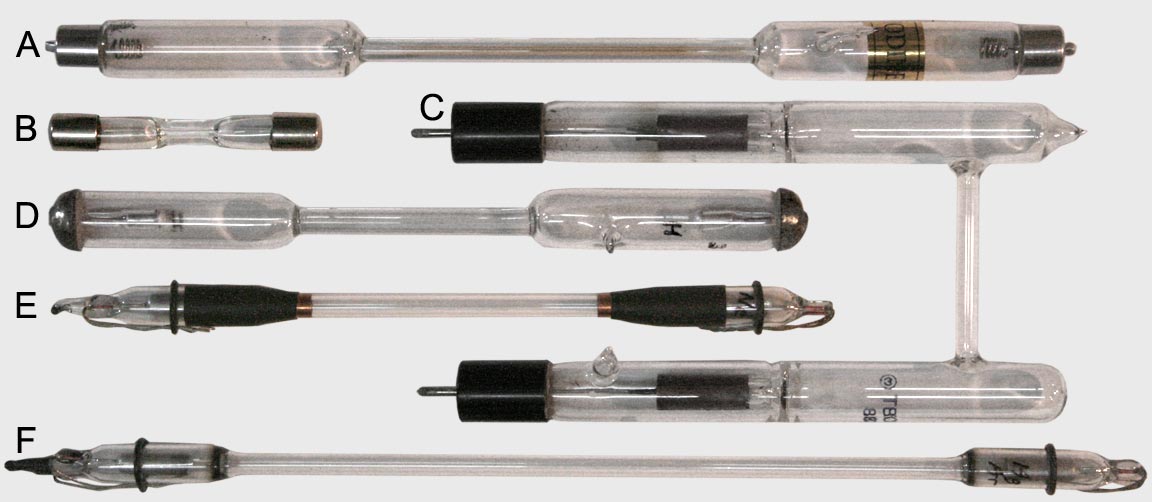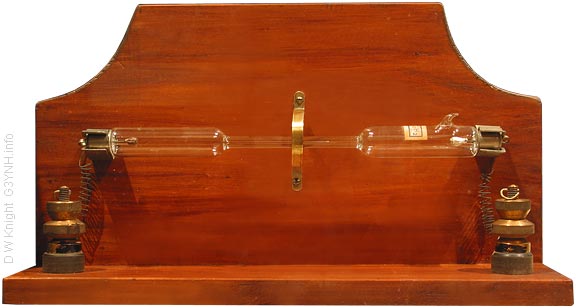 |
Spectrum Tubes |  |

Various Spectrum Tubes. A: 'Standard' 26cm tube (I2). B: Russian 'Nixie gas' tube Melz TNUV 0482 (He-Ar mix). C: Russian TVS-15 tube (H2). D: Russian 19cm tube (H2). E: Peter Jameson 19cm tube (Ne). F: Peter Jameson 26cm tube (Hg-Ar). (E and F have rare-earth oxide cathodes).
Introduction .
A spectrum tube has a narrow (capillary) mid section and contains gas or vapour at low pressure. The capillary eliminates the need for a slit-collimator when examining the light output with a simple prism or grating spectroscope, and it ensures high brightness when a slit is used. This type of tube, with a wide choice of fills, is used for Teaching Laboratory demonstrations and is still readily available (cost ca. £10 - £60 UK inc. VAT from educational suppliers). The 'standard' length of 26cm allows the tubes to be used in a variety of nominally-safe high-voltage power supplies designed for teaching purposes. The 'safety' of the Teaching PSU comes from recessing the tube end-caps during operation, but freedom from electric shocks and burns is by no means assured. The PSU can typically produce up to 4kV to start the tube, and will then run it at about 1kV (depending on the fill type and pressure). Note that, for a current of 10mA, this corresponds to about 10W, which means that tubes can get very hot and should only be used for short periods. Some power supplies have a control enabling the brightness to be reduced after starting, but true constant-current operation is typically not achieved in the cheaper units, and continuous use is still not advised.
Note that Hg tubes generally also contain some Ar to get them started. The Hg spectrum lines at 436 and 546nm are typically used for spectrometer calibration.
Eisco states that its tubes have pure Nickel electrodes. Most tubes with coiled wire electrodes are probably the same. Cup electrodes with rare-earth oxide thermionic coating (sign-tube cathodes) are can radically increase tube life, but are not often used.
 Mercury
spectrum tube operated at very low current by
using a smal DC
fluorescent tube inverter. The brighness is not sufficient for
recording the spectrum.
Mercury
spectrum tube operated at very low current by
using a smal DC
fluorescent tube inverter. The brighness is not sufficient for
recording the spectrum. Neon
spectrum tube operated at low current. In this
case a
good high-brightness arc has struck in the gas column. The beading
effect depends on the inverter running
frequency and gas pressure and is possibly an acoustic resonance. It
often becomes invisible if the frequency is changed by
increasing the current, but then the tube will get hot and
must be switched off after a short period. Beading is discussed in more
detail in Peter
Jameson's article.
Neon
spectrum tube operated at low current. In this
case a
good high-brightness arc has struck in the gas column. The beading
effect depends on the inverter running
frequency and gas pressure and is possibly an acoustic resonance. It
often becomes invisible if the frequency is changed by
increasing the current, but then the tube will get hot and
must be switched off after a short period. Beading is discussed in more
detail in Peter
Jameson's article.
 Capillary
spectrum tube, ca 1930, labelled C2H2
(acetylene).
Capillary
spectrum tube, ca 1930, labelled C2H2
(acetylene). This item is in the collection of the Porthcurno Museum of Global Communications. (where it was catalogued, somewhat generically, as a "Crookes Tube" when viewed by the author some time before 2012).
Tube suppliers:
www.eiscolabs.com/ Eisco scientific online catalogue.
www.rapidonline.com/ [Eisco tubes - type 'spectrum tube' into the search box]. Also supplies Eisco PH1197B tube holder at a good price.
www.betterequipped.co.uk/ [type 'spectrum tube' into the search box].
Philip Harris [type 'spectrum tube into the search box]. Also supplies a 26cm tube holder, but more expensive that the Eisco..
Select School Supplies [type 'spectrum tube into the search box]
See also Indian suppliers on ebay, but beware: if buying a tube bundle, make sure that the gases to be supplied are listed.
An 18-tube bundle might contain: Hg, Ar, Air, NH3, C2H5OH, Ne, N2, I2, Cd, Cl2, CO2, H2, He, Kr, H2O vapour, Na, S and O2.
Accessories:
Neon tube transparent supports for 6 - 20mm diameter.
Beading:
Acknowledgement:
Thanks to Peter Jameson for supplying the inverter used for the low-current discharge pictures above. Peter makes tubes and scintillation screens and sells them on ebay:
Peter's tubes are superior to the typical Teaching-Lab spectrum tubes from educational suppliers because they have Barium Oxide coated thermionic cathodes as opposed to coiled Ni wire inserts or plain metal. They can be operated continuously from a 3 kV 30 mA neon-sign transformer to give a nominal life of 2000 hours. The ZnS:Ag scintillator screen can be used to detect α-particles and UVC from silica-walled Hg tubes.
Thanks also to Pete for reminding me of the neon signs and Fire Safety switches that were everywhere when I was a kid.
Pete has no website, but there is now an article on this site: The Art of Discharge Tube Making, in which he describes his various experiments and activities:
| |
 |
|
|
 D. W. Knight, 2013 - 2021.
D. W. Knight, 2013 - 2021.Last update: 2021 July 23rd.
